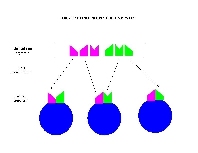| Introduction |
| Recognition of the Immune System |
| Generating Receptor Diversity |
| Affinity Maturation |
| Organizing Principles |
| Possible Architectures |
| Artificial Immune System |
| Summary |
Generating Receptor Diversity |
Because detection is carried out by binding with nonself, the immune system must have a sufficient diversity of lymphocyte receptors to ensure that at least some lymphocytes can bind to any given pathogen. Generating sufficient diversity is a problem because the human body only makes on the order of 106 different proteins, which the immune system must use to construct receptors that can recognize potentially 1016 different proteins or patterns.
How does the immune system produce the required diversity of receptors?
 Figure . Receptor diversity is generated by randomly
recombining parts of inherited gene segments.
Figure . Receptor diversity is generated by randomly
recombining parts of inherited gene segments.
Lymphocyte receptors are constructed from inherited gene segments or libraries. The receptors are made by randomly recombining elements from different libraries, resulting in an exponential number of possible combinations, and hence a huge diversity of receptor structures (see figure ). This combinatorial explosion allows the immune system to make potentially 1015 different kinds of receptors, although the actual number of distinct receptors present in the body at any given time is far less than this. Estimates place the number at between 108 and 1012 distinct receptors present at one instance.
If the diversity of receptors present is several orders of magnitude less than the diversity of pathogen patterns, how does the immune system detect most pathogens?